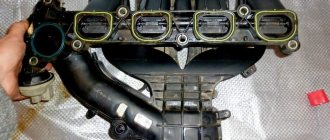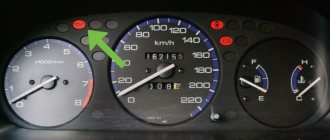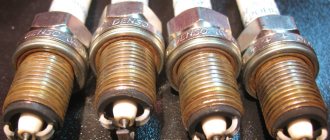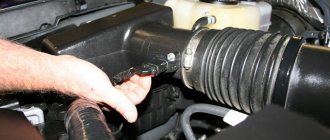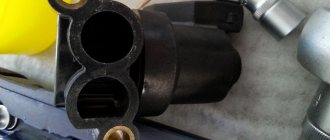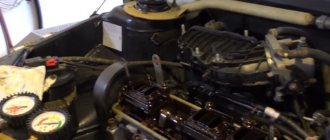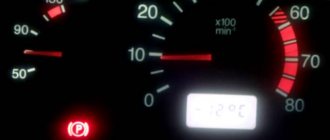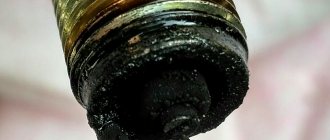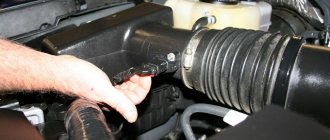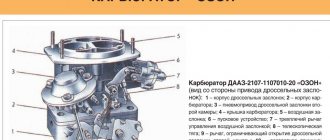Idle mode is the operation of an unloaded engine. That is, the engine (ICE) is running, but the transmission is disconnected from it, and the car is not going anywhere. Unstable engine operation indicates malfunctions in the power and ignition systems, this is primarily, as well as breakdowns and failure of adjustments in the gas distribution mechanism and in some other “assisting” mechanisms and systems to the engine.
Vibration at idle in the morning is (supposedly) normal; This is exactly what would-be masters and other “non-professionals in their field” like to say. In the normal state of the power plant, with all the above-mentioned systems, components and mechanisms functioning normally, vibration is EXCLUDED! There should be no vibrations in a technically sound engine.
And on a used engine, vibration definitely occurs and negatively affects not only the operation of the engine itself, but also the entire car as a whole. Its presence indicates that it’s time to go to a motor mechanic for a car service. We will talk about the causes of internal combustion engine vibration and ways to eliminate it in this article.
The main causes of engine vibration at idle speed
Unstable engine idling can be caused by several reasons. There are 3 (three) main reasons:
- current malfunctions in the engine itself (for example, the motor is tripping), but there can be many reasons for its “triple”;
- natural wear and tear of parts of the cylinder-piston group (CPG) during operation, when their weight begins to differ from that normalized by the manufacturer of the car (or engine);
- weakening or breakdown of parts and fastening units of the internal combustion engine.
Troit motor
An engine can fail for a variety of reasons:
- Supply system.
- Depending on the type of your internal combustion engine (diesel or gasoline/gas), depending on the type of power system (carburetor or injection), different amounts of the fuel mixture and its different composition may enter the engine cylinders. When the ignition system tries to ignite it (different in composition in different cylinders), parasitic and/or arrhythmic fires can and will certainly occur, hence the engine vibration at idle, and not only in the morning.
- Due to the natural wear and tear of engine CPG parts, different compression is formed in different cylinders over time, hence the unstable operation of the engine at idle, and not only at idle.
- Due to contamination of the jets (in a carburetor power system) or injectors (in an injection engine), a different composition of the fuel mixture can also form with a larger or smaller ratio of air volume to the amount of fuel. These are also the causes of car vibration.
- Similar reasons affect the operation of a diesel engine, especially since the ignition of the diesel fuel mixture is significantly influenced by the pressure in the fuel system, which is provided by such an important component as the high-pressure fuel pump. Experts call it that - fuel injection pump. Here are some more reasons for car vibration.
- Ignition system (for gasoline and gas internal combustion engines).
- When the engine vibrates at idle (regardless of the type of ignition, battery or electronic), the reasons often lie in “different” spark formation. Failures manifest themselves both in the spark interruption mechanisms and at the stages of its distribution among the cylinders.
- The strength (energy) of the spark itself can also depend on the condition of the ignition system components, not only at the exit from the ignition coil (or ignition coils, if there are several), but also at the electrodes of the spark plugs. This is another reason why the engine vibrates at idle. And - I repeat once again - not only at idle and/or not only in the early morning.
- Vibration in a car can also arise from the condition of the spark plugs themselves, and primarily from the size of the gap between the electrodes - central and side (or side, if the spark plug has several of them). Usually and most often the central electrode burns out. If these gaps are different on different spark plugs, even within tenths of a millimeter, and this is exactly what happens, then this parameter can also cause engine vibration.
The quality of the spark, and, consequently, the ignition mechanism of the fuel mixture, is also influenced by such factors as:
- condition of high voltage wires,
- condition of the ignition coil (or coils),
- short circuits to ground,
- high voltage breakdowns in the most diverse and unexpected places.
For these and many other reasons, the engine vibrates at idle, and not only at idle, and not only (I repeat) in the morning.
Optimal operating mode of power units
Many car owners think about what engine speed is the most economical. It must be said that for each engine the optimal speed indicator may vary.
- For example, diesel engines provide excellent pickup from the very bottom. Therefore, the best efficiency will be achieved at speeds of 2000 per minute.
- Whereas gasoline engines, especially turbocharged ones and those with a small volume, show the best traction at high speeds. For them, the optimal performance will be at around 3500-4000 rpm.
- If the car is equipped with an automatic transmission, the computer control unit itself will select the optimal engine speed. If you are using a manual car, you should keep the engine speed in the range from 2000 to 4000 rpm. In this mode of operation, the motor will be more economical, and you will be spared from various breakdowns.
Other causes of vibration at idle
In theoretical mechanics and in such disciplines as automobile theory and engine theory, there is simply an incredible number of causes of vibration of the engine, power plant and the entire car. These could be malfunctions of the engine itself, or malfunctions of body elements. Add to this the contamination of the fuel system with low-quality fuel at our gas stations, which entails contamination of filters and lines, malfunctions of the ignition systems, etc., etc. Add here also the quality of our roads, which loosen all the fastenings in the body - and, in the end, you will get a loose car, vibrating in all its parts. And the older he gets, the more “sausage” he gets – this is a regularity.
Motor imbalance
Before talking about the natural wear and tear of parts and assemblies of the cylinder-piston group (CPG), you should know the history of the assembly of your specific engine by the manufacturer or by mechanics at the service center if your internal combustion engine has undergone a major or even partial repair with the replacement of parts.
At most production facilities in the global automotive industry, the quality of components supplied to the assembly line is monitored very strictly, and in the elite sector and in the production of so-called high-performance engines (boosted and turbocharged), the master assembler double-checks and weighs each (every!) part on a scale before installing it into the block (or cylinder head) of the cylinders. That is why, for example, Ferrari engines can spin up to 10-12 thousand revolutions (and engines in Formula-1 cars even more), and at idle they make no louder noise than a home vacuum cleaner. If not even quieter.
And now imagine the opposite situation, when our “domestic serviceman” repairs your engine yourself, or when you buy yourself a “very used” car. When repairing an engine, a “normal motor mechanic” in a “normal car service center” is given from the warehouse 4 pistons, 4 sets of piston rings, 8 or 16 valves, plus many other components requested by him.
But a competent engine mechanic (without quotes) will take a dozen or one and a half of the same pistons from the same warehouse, weigh them all, and set aside only four for himself, but which will turn out to be very close in weight. The rest will be returned to the warehouse. And so with all components and spare parts. Such a master will first center the shafts - crankshaft and distribution shafts - in the spindle of the lathe. If he finds axial or vertical runout in one that exceeds the official tolerances, then he will definitely reject such a shaft and send it back to the warehouse.
Among other things, some internal combustion engine designs have a so-called balancer shaft, which, working in antiphase with the crankshaft, dampens vibrations and oscillations. And a competent mother will definitely double-check this detail.
But even a well-repaired engine, including a new one off the assembly line, wears out over time. The piston rings and pistons themselves wear out (and become lighter), other parts of the engine change their weight (and balancing), and some, acquiring carbon deposits and oil deposits, on the contrary, become heavier. For these reasons, there appear: vibration from the engine, vibration in the body, including sometimes even vibration of the steering wheel at idle when the car is standing (standing on the side of the road!).
What to do? The recipe is simple: to overcome all vibrations, you need to replace worn parts with new ones.
Content
The simplest reason:
Which rarely comes to mind, but is almost the most common. You have gasoline in the fuel tank whose characteristics do not match the engine's needs. And you didn’t necessarily decide to save money and fill up with 92 instead of 95: perhaps you received a low-quality refill. Low octane fuel causes the engine to rattle and sneeze, which can easily raise suspicions that they are symptoms of more serious diseases. It’s easy to check how much gasoline is to blame.
You drive to a proven gas station, fill in high-quality fuel (at least half the volume of suspicious liquid remaining in the tank) and start. If the tractor roar has become less pronounced, and the car has stopped bouncing, everything is clear; we no longer call on the cunning gas stations.
Engine mounts
Not many current car owners bother with this issue, and in vain! Yes, modern designs and materials of fastenings today are many times better quality than they were even 8-10 years ago, but they also wear out. These fasteners are a so-called silent block, where metal parts are “welded” in a special way with rubber and rubber-metal components. However, any rubber dries out and cracks over time, and eventually simply breaks. Over time, metal parts also acquire so-called fatigue wear. A break in the engine mount provokes significant vibrations in the body, which are fraught with very serious consequences for it.
Jerking when moving
If the engine starts normally, spins normally at idle, and while driving the car begins to bounce or move jerkily, the most likely cause is a problem with the contact distributor capacitor. Our actions:
- Remove the cover from the distributor;
- We move the slider almost until the contact is completely open;
- Turn the slider until it opens;
- When the contact breaks the connection, a spark jumps. If it is strong and casts a bright blue color, the capacitor needs to be changed;
- There may be other problems with the distributor;
- Incorrect gap on the spark plugs - either too large, or, on the contrary, too narrow. The solution here is simple - adjust it, and you can drive on, no longer worrying about the health of the engine;
- A loose rod that holds a runner with cams. This usually indicates severe wear on the unit. It is necessary to change either the bushings or the entire distributor.
These are all fairly minor glitches; they are not difficult to deal with, although you may need parts that are not at hand.
Late ignition
The term means that the supplied gasoline does not stop burning at the outlet. To fix the problem, you need to reset the octane corrector. In addition, it is recommended to lower the distribution housing a little and adjust the ignition, focusing on the control lamp - this is necessary to eliminate excessive play of the slider.
It is worth checking all wiring connections in the ignition. Oxidized plugs are lubricated with machine oil and crimped. The nuts that secure the wires to the ignition coil are screwed together and screwed on again - often one of the ends comes off under them, and this measure eliminates the break in the circuit.
About air leaks
The penetration of foreign air into the cylinders of a running engine is imperceptible while driving, since the proportion of non-flammable gas is relatively small. But “floating” and high engine speeds appear at idle, when little fuel is supplied to the chambers. Air leakage due to the movement of the pistons is possible from the following places:
- gaskets under collectors and at other joints;
- broken vacuum booster of the brake system;
- throttle body;
- various vacuum connections;
- adsorber purge system.
Read more about the problem here
To detect air leaks at gaskets and joints, you can use another old method. Fill the syringe with gasoline and squeeze the fuel onto the suspected leak. The operation is performed with the engine running. If fuel penetrates into an invisible gap, it will inevitably be drawn by the pistons into the combustion chambers. The speed of the power unit will increase and will not decrease until you stop filling the gap with gasoline.
Contamination of the crankcase ventilation system
The crankcase of any engine contains crankcase gases, their quantity directly depends on the degree of wear of the cylinder-piston group. When increased pressure occurs in the crankcase, some of the gases are supplied to the intake manifold through the open crankcase ventilation valve. Along with the large volume of crankcase gases, oil mist from the crankcase also enters the intake manifold. Oil settles on the surface of the valve elements and can cause it to jam. A jammed valve disrupts the calculated flow of air into the intake manifold and the engine runs on a rich fuel mixture and the engine speed begins to fluctuate.
